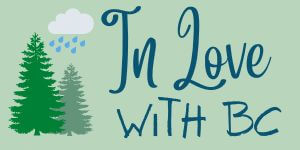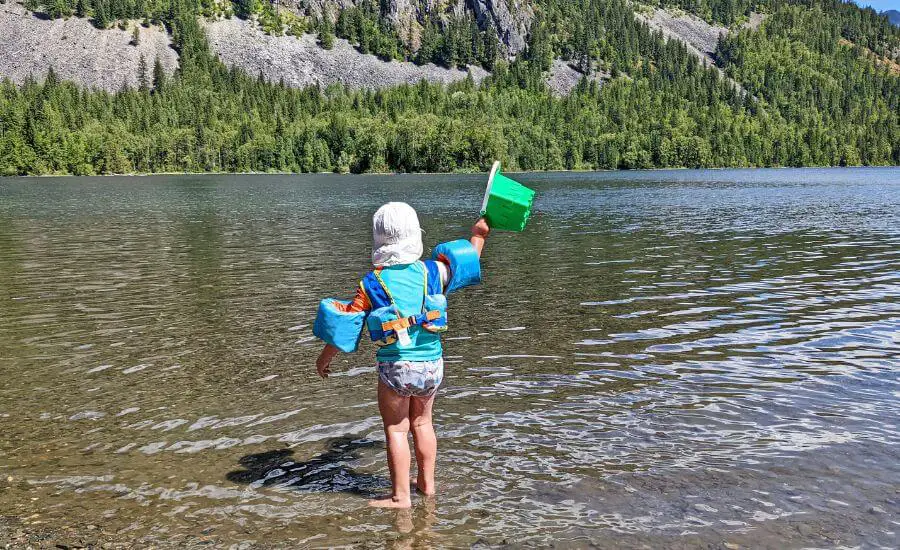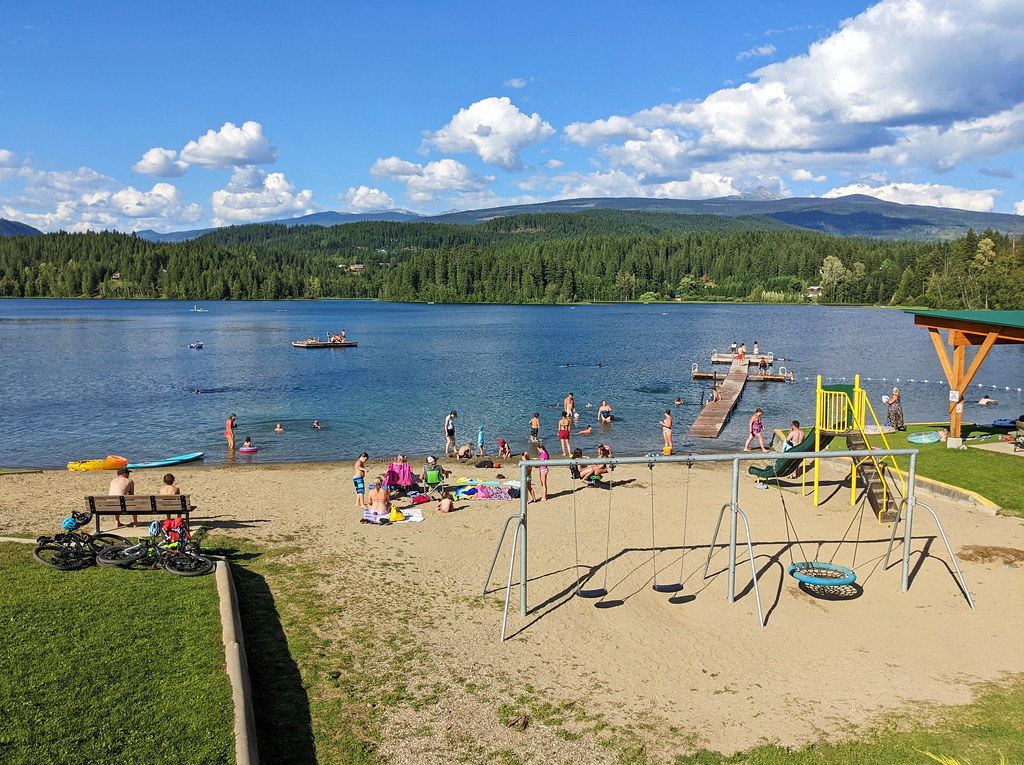Toddlers are not babies anymore, but they still have very sensitive skin, only they don’t have the ability to stay put in the shade. My toddler surely loves playing in the sand and water all day long, and he couldn’t care less about harmful UV-rays or my effort to set up the beach cabana where he plays – ten minutes later, he’ll play somewhere else.
But overexposure to the sun can cause long-term damage to the skin, especially to toddlers’ sensitive skin. The UV radiation from the sun can cause sunburns, heat exhaustion, skin cancers and heat rashes.
long sleeve rash guard top
My most effective sun protection for my toddler? Loose-fitting clothing that covers as much skin as possible, like a long-sleeve rash guard when we are on the beach.
Sun protection is a combination of things, anyway. It involves seeking shade, applying sunscreen, wearing protective clothing and sunglasses.
Find the best beaches in and near Vancouver:
- Local’s Guide To The Best Beaches In Vancouver
- 16 Fabulous Lakes Near Vancouver To Visit This Summer
- Best Beaches In West Vancouver
Things to consider when choosing a toddler rash guard
Size and fit
It’s not enough to simply buy a 24 months old size for your 2-year-old. Check the size chart, measure your toddler’s chest, waist, and height to determine the size that would really fit. Make sure the rash guard is not too tight or restrictive, and your toddler can move freely while wearing it.
Sun protection
enjoying the wading pool in Blue Mountain Park, Coquitlam
This is the main reason you buy it, so make sure it has a high UPF (Ultraviolet Protection Factor) rating, preferably UPF 50+, so that it blocks most of the harmful UV rays. Also, make sure the design offers as much skin coverage as possible, by covering most of your toddler’s body, including the back, chest, arms, and at least part of the legs.
Material
General outdoors clothing can offer UPF 50+, but the advantage of a rash guard is that the material resembles those of the swimsuits. It should be lightweight, breathable and quick-drying so that your kid can go in and out of the water all day long, and they won’t get overheated while playing in the sun either.
on warmer climates, both long sleeves top and long sleeve pants are important (this picture was taken on a summer beach day in Australia)
On the other hand certain rash guards provide warmth when you’re in colder water. They make the surfing, snorkeling or scuba diving experience better, and they can be worn in addition to a wetsuit.
Nylon or polyester blends are the most common materials as they are durable and affordable. Make sure the texture is soft and doesn’t irritate your toddler’s skin. Flatlock seams are less likely to cause chafing as they don’t rub against the skin.
Durability & cleaning
as much skin coverage as possible on a beach day in Sydney
It should withstand frequent use and exposure to sun, saltwater and chlorine. Choose quality materials, and make sure they’re machine washable to keep your life less complicated. In any case, use cold water only to wash them so that they retain their shape and color.
The best one piece toddler rash guard: Jan & Jul long sleeve jumpsuit rash guard (for boys and girls)

Jan & Jules is a Vancouver based company, and besides the great protective gear they have for rainy weather, they have a large selection of clothing for sun protection, as well.
This one-piece jumpsuit rash guard offers 50+ UPF sun protection and is great for the average beach day. No chemicals are added, the sun protection comes from the weave of the fabric, and it won’t wash off. This jumpsuit covers the neck, arm and part of the legs, down to the knee, which is usually good enough. Thanks to the one piece design it perfectly covers your kid’s back and waist, and it won’t ride up. There are no separate pieces to manage, so dressing up can be quicker.
It’s a spandex blend that allows easy movement, and the full zipper closure makes it easy to take it on and off, even when it’s wet. Diaper change is also quick and easy.
The fabric feels soft, it’s durable and quick-drying, with low water absorption. Oh, and it’s available in various nice colors and patterns, both for boys and girls.
Features:
- 50+ UPF sun protection
- full zipper closure
- flat lock seams
- high neck, long sleeves and knee length legs
Sizes: 6 months to 3 years
Check current price and purchase here.
The best one piece rash guard for maximum skin coverage: Honeysuckle one piece long sleeve swimsuit (for boys and girls)
If you’re looking for a swimsuit that offers full body coverage, here you are: this Honeysuckle one piece rash guard is available in unisex, boy and girl designs. While knee length legs give adequate protection for the average summer, tropical beach days are different. Also, the younger your toddler is, the more skin coverage you want.
This model comes in relatively small sizes, anyway, because it’s designed for babies and young toddlers, up to 2 years old. It has an inseam zipper for easy diaper change. For older toddlers, two piece swimsuits are more practical.
The material is good quality, exceptionally breathable, quick-drying and chlorine resistant. It has a 4-way stretch ability, so it will provide a comfortable fit and won’t restrict movement. The front zipper could go down a bit further though, so that it would be easier to take the suit off when it’s wet.
Features:
- 50+ UPF sun protection
- 4-way stretch fabric
- inseam zipper for diaper change
- high neck, full body coverage
Sizes: 12 months to 24 months
Check current price and purchase here.
The best two piece toddler rash guard: Jan & Jul two piece long sleeve swimsuit (for boys and girls)

This is another model from Jan & Jul. They offer very good quality and non-toxic swimsuits, and this model is a two piece set, designed for older toddlers. As my son grew, I started to prefer the two piece sets, but there’s no ultimate perfect choice here, every mum and kid have their own preference.
The two piece swimsuit offers greater flexibility and ease of movement, and it makes it easier to manage bathroom breaks. Then you’ll also have the option to mix and match different tops and bottoms, creating different outfits. It can certainly happen that your toddler grows out of the top, but the bottom still fits, or the reverse.
The long sleeves and high neck of this swimsuit provide perfect protection for the upper body, while legs are also protected down to the knees. It has 50+ UPF sun protection, just like each item in this list.
The spandex blend ensures a comfortable fit, while the flat lock seams won’t irritate your toddler’s sensitive skin. It doesn’t have a zipper, but it’s easy enough to pull it on and off over the head.
Colors and patterns are adorable. You can easily find typical boy’s or girl’s patterns and colors, but also designs that are unisex.
Features:
- 50+ UPF sun protection
- flat lock seams
- high neck, long sleeves and knee length legs
Sizes: 6 months to 5T
Check current price and purchase here.
The best two piece rash guard for maximum skin coverage: Happy Cherry two piece long sleeve swimsuit set (for boys)

This is a two piece set that provides full body protection for older kids, from 4 years up to 12 years old. Okay, I know, a 4-year-old is not really a toddler anymore, but there are tall toddlers (uhm… like mine) for whom the pieces that offer sizes for 1-3 year-olds won’t fit. Their mums will be happy to know that yes, full body rash guards are sold for older kids, too.
The polyester-spandex blend has 50+ UPF sun protection, it’s quick-drying and elastic. It consists of a long sleeve rash guard swim shirt and long swim pants with elastic waistband. It’s great for swimming, wading, surfing, diving or water games, especially on tropical beach holidays.
Most of the patterns and colors are typically for boys, however, some of them are unisex.
They’re hand washable though, maybe cold machine wash.
Features:
- 50+ UPF sun protection
- flat lock seams
- high neck, long sleeves and knee length legs
Sizes: 4-12 years
Check current price and purchase here.
The best one piece long full body rash guard for older toddlers: Dive and Sail one piece long sleeve rash guard (for boys and girls)

In case you’d prefer a one piece rash guard with full body coverage for older toddlers, this one could be a great choice, both for boys and girls.
It provides 50+ UPF sun protection, the fabric is stretchy and allows movement. It has a zipper closure so that it’s easy to take it on and off.
It runs small, so ordering a bigger size results in a good fit in most cases.
Features:
- 50+ UPF sun protection
- zipper closure
- Full body coverage
Sizes: S – XX (check the size chart, it’s for older toddlers and kids)
Check current price and purchase here.
The best toddler girl swimsuit: Jan & Jul long sleeve girls’ UV swimsuit

This is a traditional girls’ swimdress with a long sleeve rash guard. The 50+ UPF sun protection comes from the weave of the swim-suit fabric, no chemicals are added and it doesn’t wash off. It’s great for regular swimming, beach or poolside activities.
The spandex blend fabric is soft and quick-drying, with low water absorption. Patterns and colors are very cute, I love all the fruits and flowers, they simply have a happy vibe.
Features:
- 50+ UPF sun protection
- zipper closure
- flat lock seams
Sizes: 6 months – 5T
Check current price and purchase here.
The best thermal neoprene diving suit: Gogokids wetsuit (for girls)

Gogokids is a brand for watersport products, and this neoprene wetsuit provides not only 50+ UPF sun protection, but also 2.5 mm neoprene to keep your kid warm underwater.
A regular rash guard will be more than enough for the average beach day, this one’s for kids who spend a lot of time swimming, snorkeling, surfing, windsurfing, or even kayaking. But you can use it to keep your toddler warmer if you jump into waters that don’t warm up to very pleasant temperatures (uhm.. like the ocean beaches in Vancouver).
The wetsuit is thick, comfortable and durable, and it’s easy to take it on and off with the back zipper closure. Based on both the sizes and the features, it’s for older toddlers and kids.
Features:
- 50+ UPF sun protection
- back zipper closure
- full body coverage
Sizes: S – XX (check the size chart, it’s for older toddlers and kids)
Check current price and purchase here.
Other things to pack for family beach days
Sunscreen

One great advantage of rash guards is that they reduce the amount of sunscreen you need to use, not to mention that they block the harmful UV rays more effectively than sunscreen. Skin coverage is always the better option. But you can’t cover everything, so you still need a good quality sunscreen for your kid’s face and the rest of their exposed skin.
When it comes to choosing sunscreen, two things are equally important: it should offer appropriate protection (at least SPF 30, but 50+ is even better for the face), and it should be skin-friendly. The point is not to buy a sunscreen specifically made for kids, because ingredients matter more than how the product is labeled.
Mineral sunscreen is the best both for humans and the environment. They lay on top of the skin, creating a barrier that reflects UV light. They don’t absorb into the skin. This Blue Lizard mineral sunscreen is a great choice both for kids and adults, it provides SPF 50+ sun protection, it’s paraben-free, fragrance-free, sweat and water resistant.
Don’t forget to apply sunscreen every two hours, or more frequently if your toddler is in water or sweats a lot.
Lip balm
Hot and dry weather is harsh on the lips, too, so make sure to pack a lip balm. Burt’s Bees Original Beeswax has 100% natural ingredients, and beeswax is effective in moisturizing and hydrating your lips.
Sunglasses

Protect your toddler’s eyes with a pair of sunglasses that has UV protection. They should block 100% of both UVA and UVB rays, have a comfortable fit and be cute enough so that they actually want to wear them. Like this one.
Sun hats
Wide-brimmed hats that shade the face, neck and ears, give the best protection. Make sure they also have a high UPF rating. This model from Jan & Jul is water repellent, has UPF 50+ protection with full neck coverage, and they have very cute hats for both boys and girls.
Thanks to the chin strap they’ll stay on even in windy conditions, and the fully adjustable head drawstring makes it suitable for several reasons.
They are hand wash only (but you don’t need to wash them too often).
Umbrella, beach tent or beach cabana
If there’s not enough natural shade on the beach, some form of sunshade comes handy, especially in the hottest part of the day.
Umbrella? Easy to set up and takes up relatively little space. It’s also easy to move around once you’re on the beach. However, it won’t be useful at all if it’s a windy beach (like most ocean beaches).
Beach tent? Unlike most umbrellas, a beach tent withstands the wind, and it also creates a more isolated space to put small kids to sleep during the day. You can find very compact beach tents, so size shouldn’t be an issue, but there’s one thing I don’t like about them: they heat up, and ventilation is not that good inside the tent.
Beach cabana? The beach cabana is like an umbrella, but it withstands the wind much better, and it’s like a tent, but without walls, so ventilation is not a problem. It gives you less privacy though than a beach tent.
Drinking water!
Finally, have plenty of drinking water. It’s usually not a problem on city beaches, but if you visit a more remote beach, you should take the amount of water that’s enough for the whole family for the day. And make sure your kid actually drinks enough, because one can forget about it while being in the water.
Looking for even more fun activities to do with kids in British Columbia, Metro Vancouver and beyond? Click here to see some other places I explored with my son.
Also, being a full-time mom of a toddler meant quite a large amount of time on playgrounds, and we tested the ones not only in Vancouver, but also in Burnaby, West Vancouver and North Vancouver.













